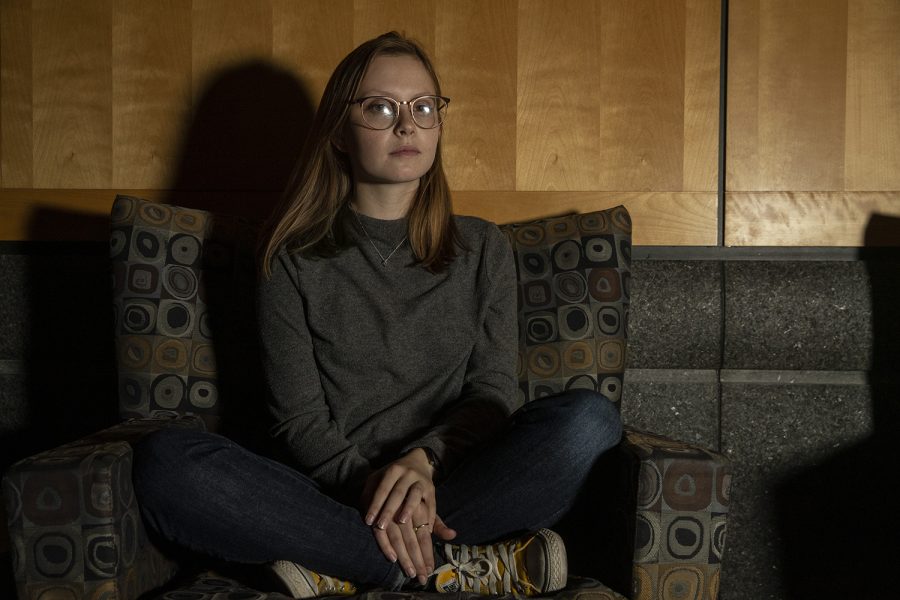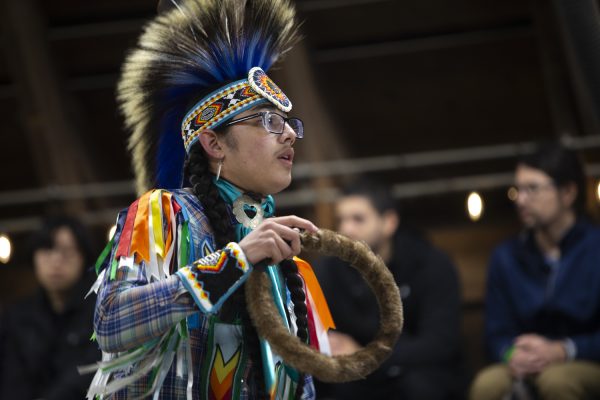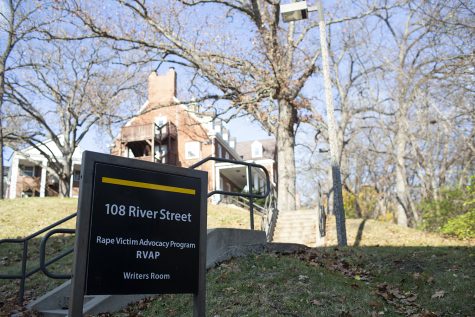Tracing the origins and present-day resurgence of anti-Semitism
A DI staffer investigates the origins of anti-Semitism and the troubling signs of its 21st century resurgence — showing its face across the United States, including Iowa City.
Madison Lotenschtein poses for a portrait in the Adler Journalism Building on Wednesday.
My father, Daniel, was having dinner at his friend Oscar’s house when Oscar’s father said, “I get along with everyone, except the Jews.”
“But Dad,” Oscar explained, “Dan is Jewish.”
“Oh no, I get along with you,” his father said while gesturing toward Dan, “You’re not like the rest of them. You don’t act like a Jew.”
This scene transpired while my father was living in Buenos Aires during the late 1970s; a period of time when the government was run by a dictator who caused 30,000 people to disappear. Intimidated by his friend’s father — who was a colonel in the Argentine Army at the time — my father kept silent. Intimidation is a feeling that enables most people to stay rooted in fear, unmoving, silent, hoping that the hands working their government’s garden won’t uproot them.
Anti-Semitism reached its peak during the Nazi occupation of continental Europe, demolishing millions of generations worth of Jewish families. But the ending of the war and liberation of the concentration camps doesn’t mean anti-Semitism disappeared entirely. It has made a resurgence from the mid to late 20th Century. Anti-Semitism has morphed into a sly figure, broken away from its nationalist persona. It has transformed into a shape-shifter that eerily matches the world’s political attire of the 21st Century: camouflage.
However, anti-Semitism was not a trend that merely existed in one decade and slowly crept up the ladder of hate crimes. Anti-Semitism has existed for thousands of years, starting with the inauguration of Christianity as an accepted religion in the Roman Empire. Until 1965, the Catholic Church claimed that the Jews killed Jesus, demonizing them, even though Christianity would simply be nonexistent without the crucifixion of Jesus, begging an ample mind to laugh at the irony that is the foundation of many religions.
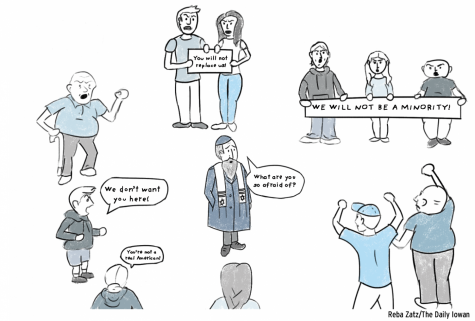
With the unity of the church and state in medieval times, Jews were isolated from their gentile neighbors, residing in shtetls, or Jewish villages. Such segregation led them to be frequently attacked and blamed for causing the black plague because so few Jews were dying from it. If only their gentile rulers could deduce the concept of kosher and cleanliness that is so deeply rooted in the Jewish faith.
Hate for Jews escalated throughout the years as the first waves of Jewish immigrants arrived in the United States. Political anti-Semitism rose through the U.S. under the guise of nativism and anti-immigration, according to Professor Elke Heckner, who teaches Holocaust, genocide, and film studies in the University of Iowa German Department.
“If we think about it, especially in the 1800s and back, even though we don’t live in that type of society anymore, the attitudes were clearly formed at that time and were passed on,” Heckner said.
I have been unfortunate enough to have encountered anti-Semitism on a small, but worrying, scale. During a Snapchat group-chat call a few months ago, an old friend said to me, “Maddie, you’re the only Jew I like.” I nervously laughed it off, wanting to believe it was just a joke. But the underlying truth is that it wasn’t, and that “joke” stems from thousands of years’ worth of hate.
While this remark is less extreme than my father’s past situation, the phrase still stung and left me with a concern that there are anti-Semites whose views may not align with the Nazi regime but are within the same acre: they hate Nazis, but don’t like Jews.
There are anti-Semites whose views may not align with the Nazi regime but are within the same acre: they hate Nazis, but don’t like Jews.
— Madison Lotenschtein
This unfortunate example could mirror the way both major parties of the U.S. are blatantly anti-Semitic. The far left normalizes the genocide by diminishing the memory of the Holocaust by comparing its horror to any act of injustice, such as the crisis with the migrant detainment camps at the border.
“The Holocaust has oftenbecome a symbol that has been emptied out of its historical specificity, of being explicitly directed against anything Jewish,” Heckner said. “When compared to other atrocities or conflicts, the Holocaust just becomes an empty shell to stand in for other political violence no matter how small.”
That doesn’t mean one shouldn’t participate in comparative Holocaust studies. Heckner herself teaches a class that analyzes the similarities between the ages of the Holocaust.
“When used in comparison it is intended to validate whatever else it is being compared to thus deflecting from the significance of the Holocaust,” Heckner said.
Anti-Jewish rhetoric is seen all across Twitter and drives the question of whether or not the United States is doing enough to monitor hate speech online. Europe has recently passed a strict law where people’s information cannot be used as a product. A new code of conduct between the European commission and four tech companies stipulates hate speech to be taken down in 24 hours, Heckner said.
“It’s actually being enacted, they’re doing that,” Heckner said. “They basically monitor what has been posted on their sites rather than pretending to be a neutral platform.”
The far right has its own anti-Semitic and white supremist tendencies. Some feel that it’s OK to openly announce and practice their hate towards the Jewish people. “Casual” anti-Semitism can be seen on Twitter, with one user saying, “Ight, I see what Hitler was about” while mocking orthodox Jews; but the blind hate can range from social-media slander to the synagogue shootings in Pittsburgh and San Diego in recent years.
Until recently, Trump was able to influence anti-Semites without playing one sour note against the Jews.
“Some of our political leaders seek to form a really strong relationship with Israel while also using toxic speech that stimulates or leads people to turn rhetoric into lethal action,” Heckner said.
But Jews who vote Democrat are “disloyal to the state of Israel,” according to Trump’s Twitter.
“A critique of Israel doesn’t make one anti-Semitic,” Heckner said. “What is anti-Semitic is to assume that American Jews have a dual loyalty and cannot represent American national interests, that they will always put their Jewish interests first.”
Ashley Carol-Fingerhut, the executive director of Hillel at the University of Iowa, said she has experienced being accused of disloyalty to her Jewish identity and to Israel.
“When I was a student, I remember a classmate saying, ‘Any time you say something critical about Israel, Jews call you an anti-Semite, and everyone in the classroom turned to look at me, the only Jewish student there,” Fingerhut said. “Obviously, I was confused and uncomfortable, but I wasn’t sure how to respond. When Jewish students are the target of comments made by classmates or professors that single them out because of their religion, they may be unsure if the comments warrant a formal complaint.”
58% of religious hate crimes were against Jews in 2018, according to the FBI
By 2018, hate crimes against Jews rose by more than one-third and accounted for 58 percent of religious hate crimes, according to the FBI. Synagogue shootings plagued 2018 and 2019; the bulk of these casualties came from shootings at the Tree of Life Synagogue in Pittsburgh and Poway Synagogue in San Diego.
“I think that it’s also important to understand that anti-Semitism becomes linked with a broader national agenda focused on anti-immigration,” Heckner said. “With the Tree of Life [Pittsburgh] shooting, the Tree of Life synagogue helped immigrants. They were specifically targeted because of the Jewish support of immigrants.”
Anti-Semitic acts are not foreign to Iowa City. In March 2019, the Church of the Nazarene was spray painted with swastikas and biblical verses. Oddly enough, the Church of the Nazarene also helped immigrants, Heckner said. These acts of hate and violence have undoubtedly manifested as hate toward not only Jews, but toward “foreign” people of different ethnicities: immigrants.

The audience claps after Rabbi Esther Hugenholtz speaks at the “Understanding Antisemitism” panel on Thursday, Nov. 1, 2018. The panel discussed where anti-semitic rhetoric comes from in the Bible, and the history of using it to advance anti-Semitic views.
Heckner has also witnessed anti-Jewish literature through a poster on a bulletin board at Van Allen Hall; she ripped the poster down immediately. But what can the University of Iowa do to alleviate anti-Semitic rhetoric on campus? There may be a religious studies department that has some Jewish-based courses, but the university does not offer any Jewish Studies programs to students.
“It is true that there is no program specifically devoted to Jewish Studies, but it is somewhat amazing that over the years families like the Pomerantz and Levitt families have supported a teaching presence in the Department of Religious Studies, given the small number of Jews who are enrolled at Iowa,” said Jay A. Holstein, the J.J Mallon Teaching Chair of Judaic Studies.
According to Hillel International’s website, Jewish students at the University of Iowa make up 2 percent of the undergraduate population.
Heckner believes that the UI curriculum needs a variety of Jewish-based classes.
“We need to have courses in the curriculum that do not just deal with the Holocaust,” Heckner said. “But also, with the question of anti-foreign sentiment in the U.S. and anti-immigration specifically. And we need to have courses in Jewish history.”
After the Pittsburgh shooting, Heckner has assisted with the anti-Semitism panel that was held by the UI History Department in November 2018. She hopes that the panel will be a continuing series on how to recognize the signs and rhetoric of anti-Semitism, anti-immigration, and racism on campus and in Iowa City.
“I think there could be workshops on preventing or deconstructing racism and anti-Semitism on campus,” Heckner said. “Confronting anti-Semitism should be increasingly part of the diversity, equity, and inclusion program that reaches beyond the curriculum into on-campus and local communities in light of national issues.”
Anti-Semitism has been revived, though it has always been there. It’s made its way to Iowa under the mask of normal faces instead of uniforms branded with swastikas. From the people who say, “you don’t act like a Jew, you don’t talk like a Jew,” to people who massacred dozens at synagogues, a culture, a mindset of complete ignorance continues to be passed down the generations. It’s up to us to combat it.

(she/her/hers)
Email: [email protected]
Madison Lotenschtein is an Arts Co-Editor at The Daily Iowan. Having been with the DI since...
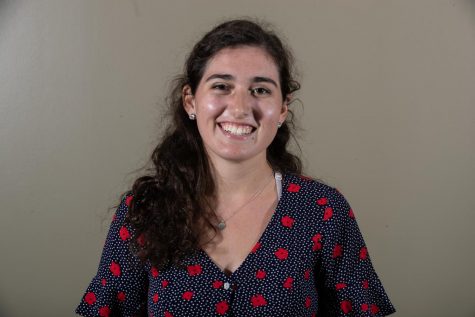
(she/her/hers)
Email: [email protected]
Katie Goodale is the Projects Assistant Visuals Editor at The Daily Iowan. She is a senior at the...



